38 Types of Bees (with Pictures): A Visual Identification Guide
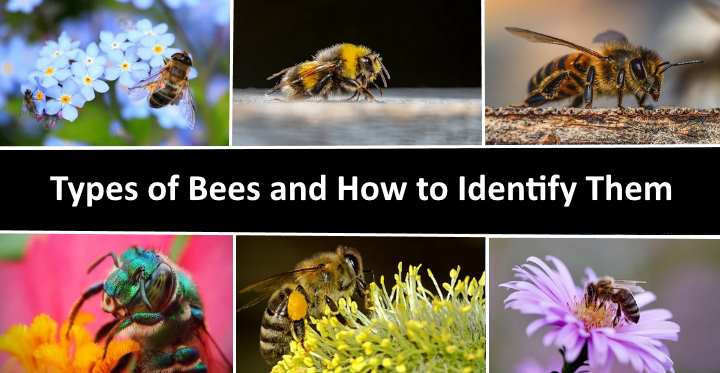
Have you ever come across a bee and wished you could identify it? This article is a visual guide designed to help you identify 38 different types of bees. Our comprehensive bee identification chart will assist you in recognizing and distinguishing the identifying features of various types of bees.
Bees are small flying insects commonly found in summer gardens, buzzing from flower to flower. Most bee species are identifiable by their fuzzy bodies, often adorned with black and yellow or orange stripes. With over 20,000 species, the Western honey bee (Apis mellifera) is the most well-known, renowned for its honey production.
Interesting Facts About Bees
Bees, especially honey bees, are generally social creatures that live in large colonies. A single hive can contain between 20,000 and 80,000 worker bees. A bee colony is also highly organized, with a queen, drones, and workers caring for the beehive.
Even though many species of bees swarm in large groups, other species are solitary creatures.
Bees play a vital role in most ecosystems. Bees are crucial for pollinating flowers so that we have crops of fruit and vegetables every year. Also, bees produce honey, a delicious sweet food enjoyed by humans, animals, and birds.
Although many bees are species of stinging insects, they are generally not aggressive. Bees are usually docile creatures and don’t attack humans. However, Africanized bees are aggressive and territorial insects. The problem is that Africanized honey bees look like regular honey bees—Apis mellifera—and can attack without being provoked.
Bees feed on pollen and nectar from flowering plants. As bumblebees, carpenter bees, and honey bees move from plant to plant, they pollinate the flowers. Honey bees then take the nectar and pollen back to the colony where they produce honey—a food source for bees that never leaves the hive.
The Seven Bee Families
There are seven recognized bee families, each containing various species that contribute to pollination and the ecosystem in different ways. These families are as follows:
Andrenidae (Mining Bees): Bees in the Andrenidae family are often solitary and known for nesting in the ground. They are important pollinators for many wildflowers and crops.
Apidae (Honey Bees, Bumblebees, and Others): The Apidae family includes some of the most well-known bees, such as honey bees and bumblebees. They are known for their complex social structures and crucial role in pollinating a wide variety of crops and wildflowers.
Colletidae (Plasterer Bees): These bees are solitary and named for their habit of lining their brood cells with a waterproof secretion. They are often important pollinators for various native plants.
Halictidae (Sweat Bees): Bees in the Halictidae family are known for their attraction to human sweat, as they often land on the skin to drink perspiration. They can be both solitary or social and are important pollinators for many crops and wildflowers.
Megachilidae (Leafcutter and Mason Bees): These bees are known for their distinctive behavior of using plant leaves or mud to build nests. They are crucial pollinators for many crops and wild plants.
Melittidae (Melittid Bees): Bees in the Melittidae family are typically solitary and often have specialized relationships with particular types of flowers. They are important pollinators for various wild plant species. The Melittidae family of bees is found primarily in the Palearctic and Afrotropical regions, which include Europe, North Africa, and parts of the Middle East.
Stenotritidae (Narrow-Headed or Plumber Bees): The Stenotritidae family includes a small group of bees known for their unique nesting behaviors. They are often found in arid or semiarid regions and play a role in pollinating various desert plants.
How to Identify Bees
Identifying bees involves studying their physical characteristics, such as size, color, and patterns, as well as observing their flight patterns and nesting behaviors. Taking note of their preferred habitats and consulting identification guides or experts can also be helpful. By familiarizing yourself with these key aspects, you can become more proficient in recognizing and identifying different bee species.
Bees vs. Wasps – How to Tell the Difference
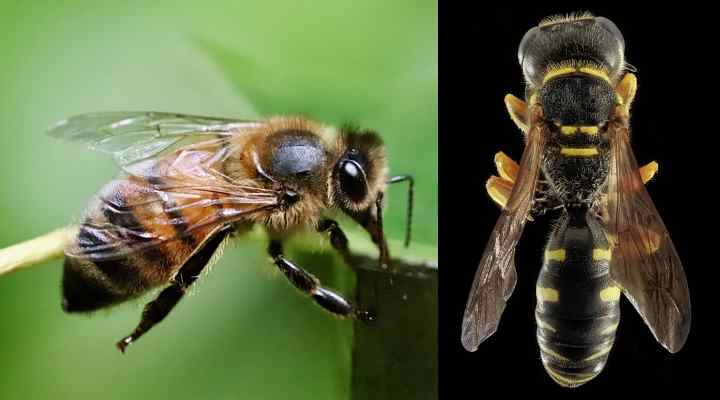
Close up pictures of a honey bee (left) and a wasp (right)
Bees and wasps, belonging to the insect order Hymenoptera, are closely related.
You can distinguish between bees and wasps by examining their body characteristics. Wasps typically have slimmer and smoother bodies, while bees exhibit a furry appearance and are generally plumper than wasps. Another distinguishing factor is that bees can only sting once before dying, whereas wasps can sting multiple times.
Types of Bees (with Names and Pictures) – Bee Identification Guide
Here is a list of different types of bees you might find buzzing around your garden (including bee identification guide with images).
Western Honey Bee (Apis mellifera)
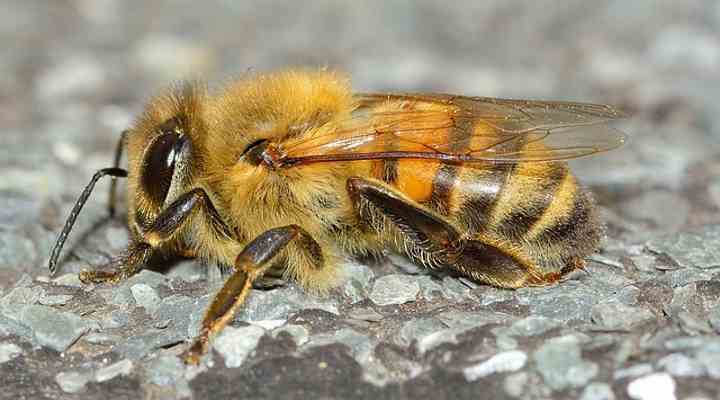
The Western honey bee has black and orange-yellow bands on the abdomen and hair on the thorax
Western honey bees have black and tan-yellow stripes on their slender bodies. Western honey bees are easy to identify as they have a honey-colored look and a relatively smooth abdomen. Honey bees have three pairs of fuzzy black legs, a pair of antennae, and two pairs of wings.
Like all bees, honey bees have a body composed of three segments: head, thorax, and abdomen. Female honey bees have hind legs with pollen pouches (corbicula) used to transport pollen to the hive. Honey bees can grow up to 1/2” (1.2 cm) long.
Western honey bees are also known as European honey bees, and they are the primary species used for honey production. Beekeepers prefer them for their non-aggressive behavior and abundant honey production.
Out of the 20,000 bee species worldwide, only eight belong to the honey bee genus Apis. These include the eastern honey bee (Apis cerana), the giant honey bee (Apis dorsata), and Koschevnikov’s honey bee (Apis koschevnikovi)
The Western honey bee (Apis mellifera) is native to Europe, the Middle East, and Africa. It has been introduced to various other parts of the world, including North and South America, Asia, and Australia, primarily for agricultural and commercial purposes.
- Name of the Bee Family: Apidae
- Common nesting locations: The Western honey bee typically builds nests in hollow trees, rock cavities, or man-made beehives. They are also known to build their nests in attics or chimneys.
- Are they pollinators: The Western honey bee is a crucial pollinator for a wide range of crops and plants. It is known to pollinate various flowering plants, including but not limited to sunflowers, clovers, and fruit trees such as apple and cherry trees.
- Do they sting: The Western honey bee is capable of stinging when it perceives a threat to its colony. They are known to sting when their hive is disturbed, or they feel their hive or queen is under attack.
Bumble Bee (Bombus)
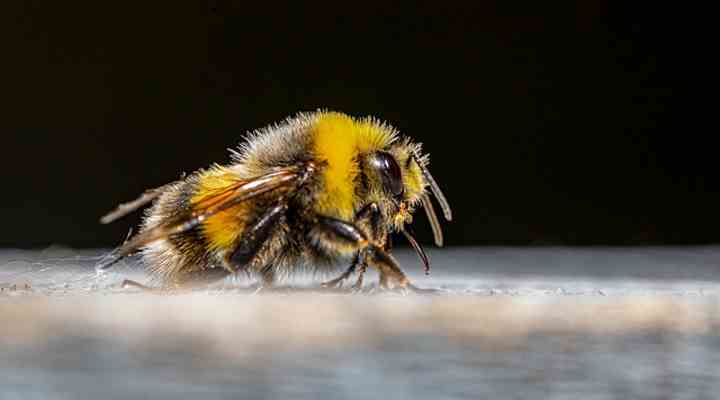
Bumble bees can be identified by their fuzzy appearance and large black and yellow body with a white tail
Bumble bees are easy to spot with their round fuzzy bodies with black and yellow stripes and white tails. Depending on the bumble bee species, they may have red or yellow tails. There are 250 individual species of bumble bees, most of which have similar identifying features. The large bees with the hairy bodies and legs grow up to 0.6” (1.7 cm).
The name “bumble bee” accurately describes their buzzing and sometimes clumsy movements while collecting pollen and nectar from flowers.
Unlike honey bees, bumble bees live in nests and smaller colonies. They only store small amounts of food in the nest. Also, bumble bees have a wider body and fuzzier appearance compared to honey bees. Similar to honey bees, bumble bees have pollen sacs on their hind legs.
- Name of the Bee Family: Apidae
- Common nesting locations: Bumble bees commonly build their nests in abandoned rodent burrows, grassy areas, or beneath piles of grass or leaves.
- Are they pollinators: Bumble bees are important pollinators for various flowering plants. They contribute to the pollination of crops like tomatoes, peppers, and berries, as well as wildflowers such as clover and lupine.
- Do they sting: Bumble bees are capable of stinging, especially when their nest or colony is threatened. They may also sting if they perceive a threat to themselves or their food sources.
Leafcutter Bees (Megachile)
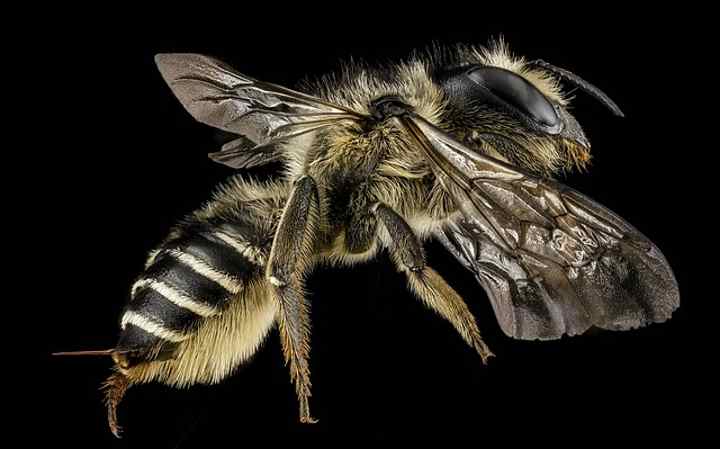
The underside abdomen of leafcutter bee has pale yellow hairs to carry pollen
Leafcutter bees have slender bodies with pronounced black and pale yellow stripes with pollen-carrying hairs on the underside of their abdomen. As their name suggests, leafcutter bees chew leaves that they then take back to the nest. Also called leafcutting bees, these insects are one of the largest genera of bees, with more than 1,500 species of Megachile.
You can easily recognize leafcutter bees by their smooth striped upper abdomen. Depending on the species, the stripes of leafcutter bees can be black and white or black and pale yellow. Leafcutter bees grow up to 0.35” (1 cm) long.
These ‘leaf-cutting’ bees are medium-sized bees that don’t produce honey. They are solitary insects that live in nests, crevices, burrows, and hollow twigs. Although leafcutter bees sting, their sting isn’t as severe as a honey bee’s sting. Up close, pictures of leafcutter bees also show they have large mandibles or jaws to slice through leaves.
- Name of the Bee Family: Megachilidae
- Common nesting locations: Leafcutter bees often construct their nests in pre-existing cavities such as hollow plant stems, wood, or even artificial nesting blocks designed for solitary bees.
- Are they pollinators: Leafcutter bees act as essential pollinators for various flowering plants. They are known to pollinate crops like alfalfa, as well as garden plants such as tomatoes, peppers, and melons.
- Do they sting: Leafcutter bees are generally not aggressive and do not pose a significant threat to humans. They are solitary and non-aggressive, stinging only in rare cases when directly handled or threatened.
Long-Horn Bees (Eucerini)
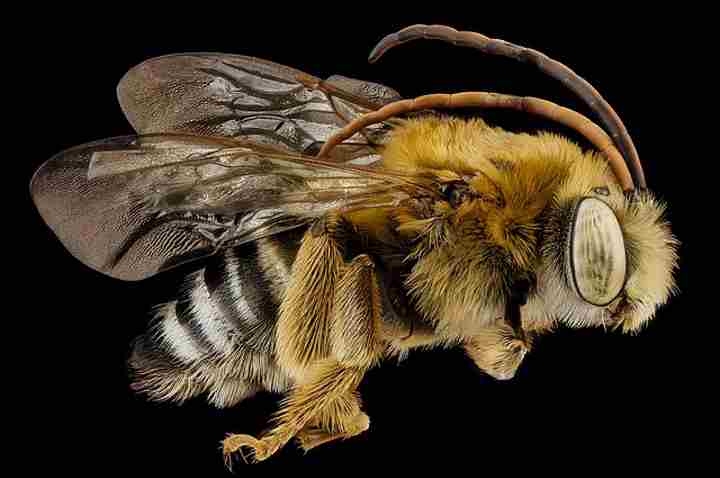
The hairy long-horn bees have long antennae with black and whitish-yellow bands on the abdomen
Long-horn bees have hairy bodies and legs with black and white bands. One common distinguishable feature of long-horn bees is their long antennae. Their six legs are fuzzy and a dark tan color.
Long-horned bees are solitary bees with about 500 species in 32 genera in the tribe Eucerini. Between the species of long-horned bees, there are few common identifying features.
Long-horn bees are commonly found feeding on pollen on sunflowers. These bees don’t produce honey and live a solitary existence where they nest in small tunnels.
- Name of the Bee Family: Apidae
- Common nesting locations: Long-horn bees often build their nests in pre-existing cavities such as hollow plant stems, wood, or even abandoned beetle burrows.
- Are they pollinators: Long-horn bees serve as vital pollinators for various flowering plants. They contribute to the pollination of plants like aster, sunflowers, and legumes.
- Do they sting: Long-horn bees are generally non-aggressive and are not known to sting unless handled or threatened directly. They typically exhibit defensive behavior if their nesting sites are disturbed or if they perceive a threat to their offspring.
Green Metallic Sweat Bee (Augochlora pura)
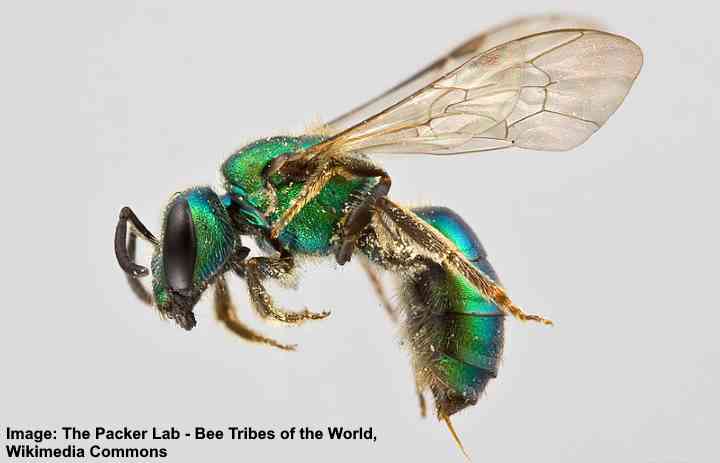
The green metallic sweat bee has iridescent body which can have green, blue and gold hues
Green metallic sweat bees have a spectacular glossy green iridescent body. These species of sweat bees are solitary insects with over 4,000 species in 81 genera. Green metallic sweat bees are tiny little types of bees measuring 0.3” (0.8 cm).
Green metallic sweat bee females live in nests in rotten wood. The males don’t survive through the winter but die in the fall.
Although the green metallic sweat bees sting, they rarely do so. But they often land on humans to lick sweat from the skin as they are attracted to salt.
- Name of the Bee Family: Halictidae
- Common nesting locations: Green metallic sweat bees commonly build their nests in rotten moist wood or underground tunnels in well-drained soil ,often in areas with sparse vegetation or exposed ground.
- Are they pollinators: Green metallic sweat bees play a crucial role as pollinators for various flowering plants. They are known to pollinate a wide range of wildflowers, including aster, goldenrod, and clover.
- Do they sting: Green metallic sweat bees are capable of stinging, but they are generally non-aggressive and not known to sting unless provoked or handled. Defensive behavior might be exhibited if they perceive a threat to their nest or if they are directly disturbed.
Carpenter Bee (Xylocopa)
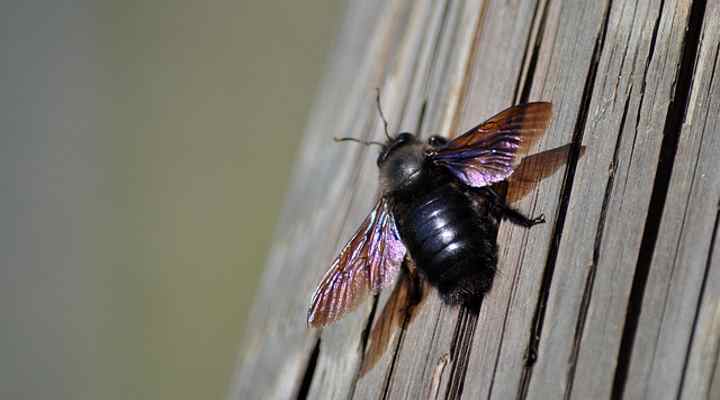
Most carpenter bee species are all black with a big black body, fuzzy thorax and smooth abdomen
Carpenter bees are big black bees that look similar to bumble bees. The difference between carpenter bees and bumble bees is that carpenter bees are less hairy. Another difference is that carpenter bees have a smooth, not fuzzy, abdomen. Most species of carpenter bees are all black, and a few species have white or yellow markings. Large carpenter bees are 0.7” (2 cm) long.
Carpenter bees get their name from their habit of burrowing in wood to nest. Another feature of these plump bees is the loud sound their wings make when they fly. Like most bees, carpenter bees sting, and their sting can be painful compared to other bee species.
- Name of the Bee Family: Apidae
- Common nesting locations: Carpenter bees construct their nests by boring into wood, such as trees, wooden structures, or even wooden furniture. They create tunnels within the wood to lay their eggs and rear their young.
- Are they pollinators: Carpenter bees act as pollinators for various flowering plants. They are known to pollinate a wide array of plants, including but not limited to passionflowers, salvias, and even some fruit trees.
- Do they sting: Carpenter bees are capable of stinging, but the males do not possess stingers, and the females are relatively docile and only sting when provoked or when they feel their nest is under direct threat.
Small Carpenter Bee (Ceratina)
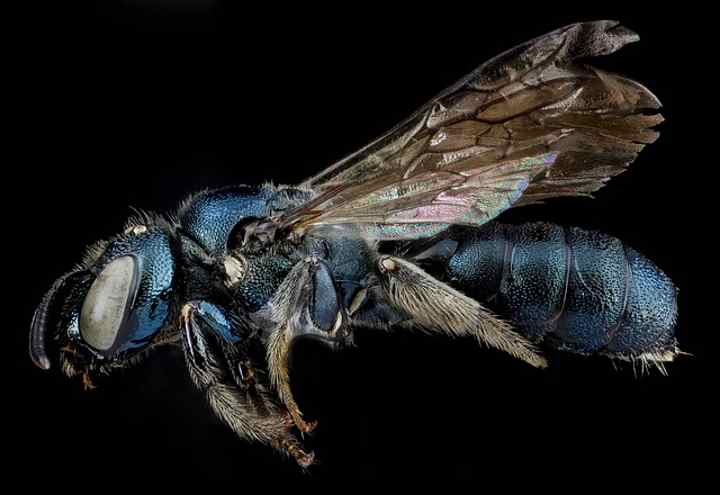
Small carpenter bees have shiny dark and smooth body with metallic blue and black hues
Small carpenter bees are little, almost hairless, bees that have dark shiny bodies that are elongated and slender. Some of these small bees have stunning metallic colors. Look for barrel-shaped bodies and stumpy squarish heads to spot these bees. Most small carpenter bees have yellow markings, which make them easy to identify.
Similar to larger carpenter bees, species in the Ceratina genus tunnel into soft or decaying wood. Some species of carpenter bees are solitary, whereas others live in social groups.
Small carpenter bees can be mistaken for sweat bees in the family Halictidae. Both genera are small with metallic coloration. However, the mouthparts of small carpenter bees are shorter than sweat bees.
- Name of the Bee Family: Apidae
- Common nesting locations: Small carpenter bees often create nests in decaying wood or pithy stems, such as those of plants like raspberries or blackberries. They construct partitions within the stems to separate brood cells where they lay their eggs and provide food for their young.
- Are they pollinators: Small carpenter bees serve as pollinators for various flowering plants. They are known to pollinate plants such as goldenrod, asters, and other wildflowers.
- Do they sting: Small carpenter bees are capable of stinging, but they are generally non-aggressive and not known to sting unless directly provoked or handled. They may exhibit defensive behavior if their nest or offspring is under threat.
Mason Bee (Osmia)
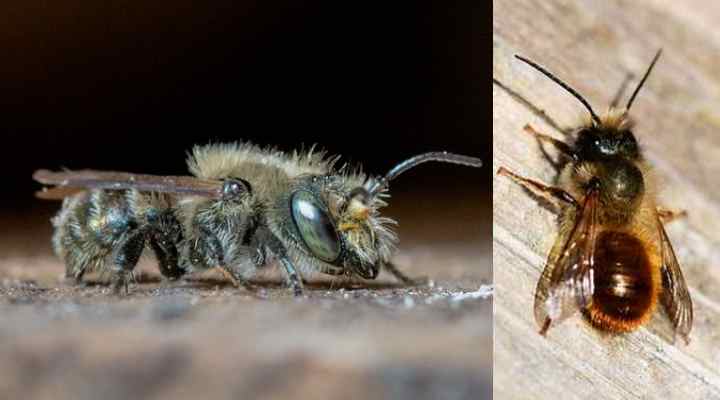
Many mason bees have metallic blue-green bodies (left picture). Some mason bees such as the red mason bee (Osmia bicornis) can have black or maroon colors (right picture)
Mason bees commonly have metallic green or blue bodies with sparse hairy patches. Some species in the Osmia genus are rust-red colored or black bees. Adult mason bees are about 0.5” (1.4 cm) long with large wings and six hairy black legs.
Mason bees get their name from their habit of using masonry materials such as mud to construct nests. Some small species of mason bees also nest in crevices, hollow stems, or holes in wood.
Common species of mason bees include the red mason bee (Osmia bicornis), blueberry bee (Osmia ribifloris), and the native orchard mason bee (Osmia lignaria).
- Name of the Bee Family: Megachilidae
- Common nesting locations: Mason bees are known for building their nests in pre-existing cavities such as hollow stems, holes in wood, or even artificial nesting blocks provided by beekeepers or gardeners.
- Are they pollinators: Mason bees are efficient pollinators for various flowering plants. They are known to pollinate early spring-blooming plants, including fruit trees such as apples, cherries, and almonds.
- Do they sting: Mason bees are generally non-aggressive and do not pose a significant threat to humans. They are solitary bees and are not known to sting unless directly handled or threatened.
Sweat Bee (Halictidae)
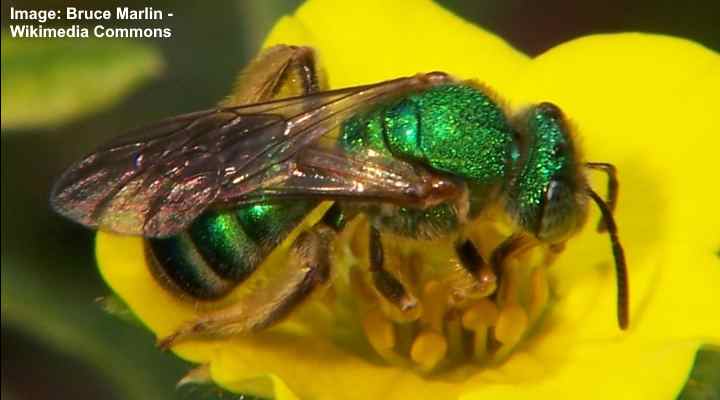
Different species of sweat bees vary in appearance, with some having green metallic body
Sweat bees in the family Halictidae can look different from one to another. Some species of Halictid are metallic green, blue, or black with greenish-yellow markings. Other sweat bees have black and white stripes on smooth abdomens. Like sweat bees in other bee families, species in this group are attracted to salty sweat.
Sweat bees are generally small to medium-sized, and can range in size from 0.125 to 0.5 inches (3 to 12 mm). They often have a slender, compact body shape. Sweat bees have a relatively hairless appearance compared to some other bee species. Their bodies are often shiny, with sparse, fine hairs, particularly on their thorax and abdomen.
Sweat bees are essential pollinators; however, they are usually solitary and don’t produce honey. These sweat bees are common throughout the eastern United States.
- Name of the Bee Family: Halictidae
- Common nesting locations: Sweat bees often build their nests in the ground, creating small burrows in soil or sandy areas.
- Are they pollinators: Sweat bees are essential pollinators for various plants, contributing to the pollination of crops such as alfalfa, as well as a diverse range of wildflowers.
- Do they sting: Sweat bees are capable of stinging, but they are generally not aggressive and are unlikely to sting unless directly provoked or threatened. Defensive behavior might be exhibited if their nest is disturbed or if they perceive a threat to their offspring.
Carder Bee (Anthidium)
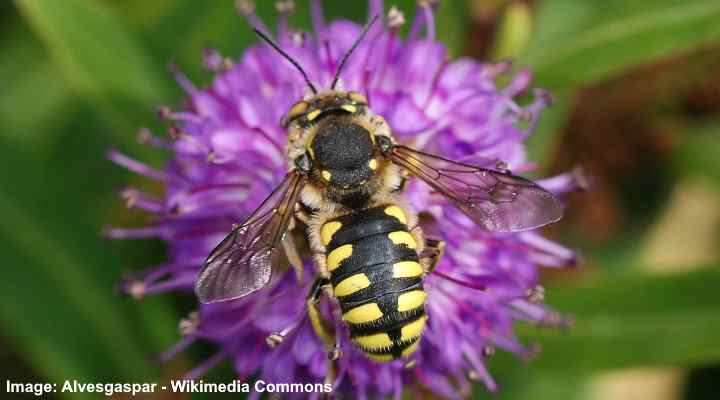
Carder bee with black and yellow markings on its back
Carder bees are large black and yellow bees that are a similar size to honey bees. Looking closely at these big bees, you’ll notice tufts of hairs on their legs and sides. The yellow markings on their abdomen don’t wrap all the way around their bodies, and they have a smooth black back.
It’s easy to mistake carder bees for yellow-jackets as their yellow and black markings are similar. However, carder bees are hairier than the more aggressive yellow hornets.
Carder bees are in the family Megachilidae, so, like leafcutter bees, they cut leaves to use in nests. These large bees also use resin, mud, and plant hairs to form their nests. Looking at pictures of carder bees, you’ll notice three horns at their abdominal apex.
- Name of the Bee Family: Megachilidae
- Common nesting locations: Carder bees are known for building nests from plant fibers, such as small pieces of leaves or petals, which they card or comb with their specialized mouthparts. They commonly nest in pre-existing cavities, such as hollow plant stems or man-made bee hotels.
- Are they pollinators: Carder bees are important pollinators for various flowering plants. They are known to pollinate a diverse range of plants, including those in the aster and daisy families, as well as flowering herbs such as lavender and rosemary.
- Do they sting: Carder bees are solitary and generally not aggressive. While they are capable of stinging, they are not known to exhibit defensive behavior unless directly handled or threatened.
Squash Bee (Peponapis and Xenoglossa)
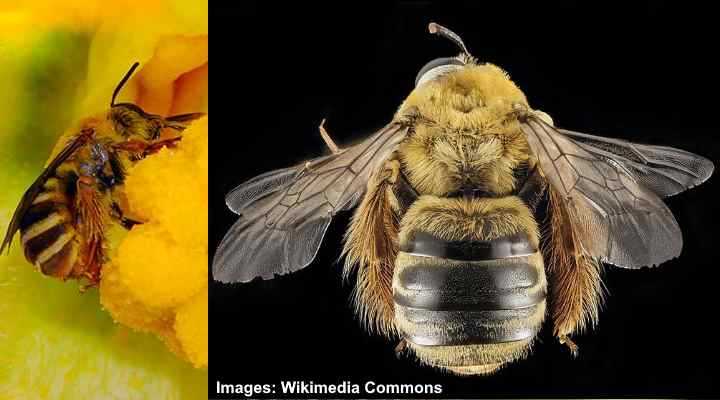
The yellow and black squash bees have a fuzzy thorax and smooth abdomen. On this picture: Peponapis (left) and Xenoglossa (right)
Squash bees are medium-sized black and yellow bees that have a hairy thorax and smooth abdominal area. Squash bees also have short, fat bodies, giving them the appearance of being squashed.
Squash bee is the common name for two types of bees in the Eucerini tribe. Squash bees get their name because they are prolific pollinators of plants in the squash family.
The stout-bodied squash bees are similar in size to bumble bees and are larger and fatter than honey bees.
An interesting feature of some squash bee species is that they are more active in the dark. The bees can start buzzing around flowers before sunrise, and others fly when it’s dark.
- Name of the Bee Family: Apidae
- Common nesting locations: Squash bees are known to create their nests in the ground, often within the vicinity of squash or pumpkin plants. They construct their nests in burrows in the soil, typically near the base of the plants they pollinate.
- Are they pollinators: Squash bees are vital pollinators for various types of squash and pumpkin plants. They are specifically adapted to pollinate plants in the Cucurbitaceae family, which includes squash, pumpkins, and gourds.
- Do they sting: Squash bees are generally not aggressive and are not known to sting unless directly handled or threatened. They are solitary bees and typically do not exhibit defensive behavior unless their nest is directly disturbed.
Striped Green Sweat Bees (Agapostemon)
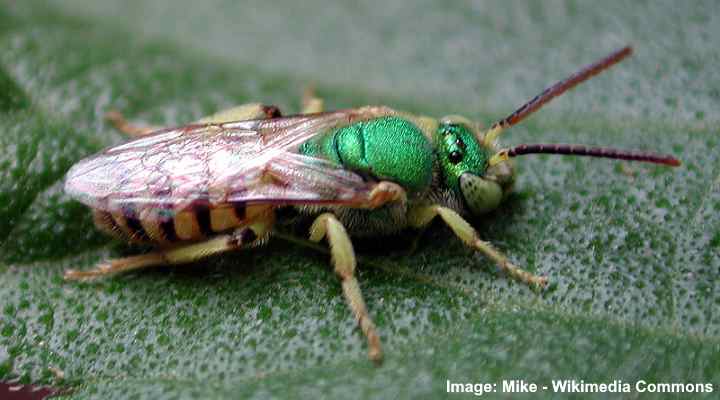
A close up image of Agapostemon texanus with metallic green head and thorax and striped black-yellow abdomen
Striped green sweat bees have a smooth black and yellow striped abdomen and metallic shiny green head and thorax. Striped green bees have long slender bodies and no discernible hairs on them. They have a striking appearance with dark antennae, lightly-colored long legs, and shiny bodies.
Striped green sweat bees are found in temperate regions in North and South America. These sweat bee species have flight patterns similar to honey bees and bumble bees.
- Name of the Bee Family: Halictidae
- Common nesting locations: Striped green sweat bees are known to build their nests in the ground, often in areas with loose or sandy soil. They create small burrows in the soil where they construct cells for their eggs and larvae.
- Are they pollinators: Striped green sweat bees are essential pollinators for various flowering plants. They are known to pollinate a diverse range of plants, including wildflowers such as goldenrod, aster, and coneflowers.
- Do they sting: Striped green sweat bees are capable of stinging, but they are generally not aggressive and are not known to sting unless directly provoked or handled. Defensive behavior might be exhibited if their nest is disturbed or if they perceive a threat to their offspring.
Miner Bee (Anthophora abrupta)
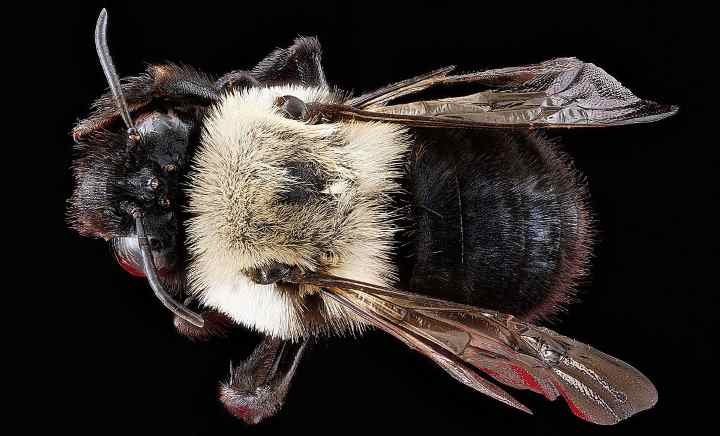
As seen in the picture, miner bees have fuzzy body with creamy-yellow hairs on the thorax and black hairy abdomen
Miner bees are fuzzy black and creamy-yellow bees similar to bumble bees. Also known as chimney bees, these medium sized, stout furry bees are coated in fine hairs, including their long legs. Mining bees usually lack stripes, and typically have a black fuzzy abdomen and a light cream or yellow hairy thorax.
Miner bees have a solitary existence. Their common name comes from their burrowing habit, where they dig tunnels in the soil. They also create chimney-like tunnels for their nests.
Although miner bees have stings, they are placid insects that rarely sting humans.
Miner bees are vital pollinators for plants such as rhododendrons, irises, roses, persimmons, and parsnips.
- Name of the Bee Family: Apidae
- Common nesting locations: Miner bees are known for building their nests in the ground. They create burrows in the soil, often in areas with loose, well-drained soil and plenty of sunlight.
- Are they pollinators: Miner bees serve as important pollinators for various flowering plants. They are known to pollinate a diverse range of wildflowers and garden plants, including those in the aster and pea families.
- Do they sting: Miner bees are capable of stinging, but they are generally not aggressive and are not known to sting unless directly handled or threatened. Defensive behavior might be exhibited if their nest is disturbed or if they perceive a threat to their offspring.
Unequal Cellophane Bee (Colletes inaequalis)
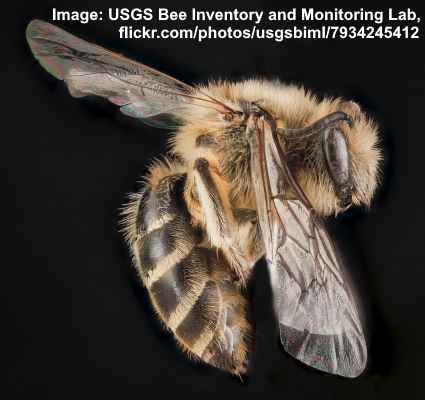
Unequal cellophane bees have fuzzy tan-colored head, pair of translucent wings, heart-shaped face, large compound eyes, and two segmented antennae.
Also known as ground bee, the unequal cellophane bee is a black and tan-colored bee with a black abdomen and tan stripes. These ground nesting bees have fuzzy tan-colored head, pair of translucent wings, heart-shaped face, large compound eyes, and two segmented antennae.
The unequal cellophane bees are solitary bees that make nests in the ground. They tunnel into dry soil to create underground nests about 6” (15 cm) long where they raise their young.
Unequal cellophane bees typically measure 0.5” (13 mm) long and are active between March and July.
- Name of the Bee Family: Colletidae
- Common nesting locations: Unequal cellophane bees are known to build their nests in the ground. They create underground burrows in sandy or well-drained soil, often in areas with sparse vegetation.
- Are they pollinators: Unequal cellophane bees serve as effective pollinators for various wildflowers and garden plants. They are known to pollinate plants such as asters, goldenrod, and other flowering plants native to their habitats.
- Do they sting: Unequal cellophane bees are capable of stinging, but they are generally not aggressive and are not known to sting unless directly handled or threatened. Defensive behavior might be exhibited if their nest is disturbed or if they perceive a threat to their offspring.
Hairy-Footed Flower Bee (Anthophora plumipes)
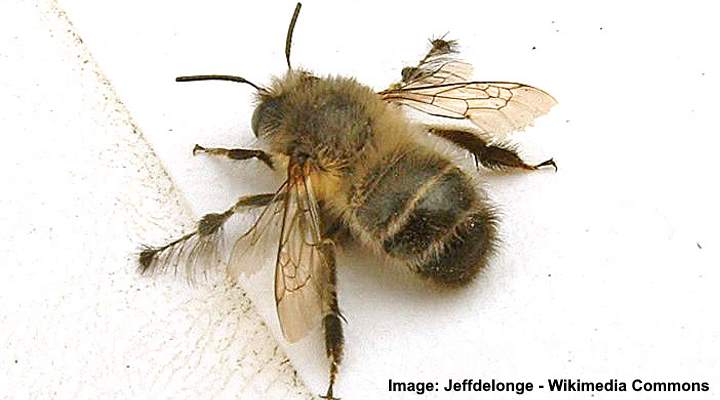
The hairy-footed flower bee is commonly found in gardens and coastal areas
The hairy-footed flower bee is a small fuzzy dark-colored bee with reddish-orange hairs, tan-colored stripes across its abdomen, and two thick antennae. There is color variation between the female bees and male species. For example, the female is dark brown to black with small tufts of reddish orange hairs. The male hairy-footed flower bee has longer legs and longer hairs on its abdomen.
The hairy-footed flower bee measures 0.5” to 0.6” (13 – 15 mm) long. The bees are usually solitary, and the females build nests in clay or mud walls. The black bees with their reddish-tan hairs are active between March and June.
- Name of the Bee Family: Apidae
- Common nesting locations: Hairy-footed flower bees are known to build their nests in various locations, including soft mortar, sandy cliffs, or even in the mortar of old walls. They create burrows in these materials to lay their eggs and rear their young.
- Are they pollinators: Hairy-footed flower bees are effective pollinators for various wildflowers and garden plants. They are known to pollinate plants such as lavender, borage, and other flowering plants found in their habitats.
- Do they sting: Hairy-footed flower bees are capable of stinging, but they are generally not aggressive and are not known to sting unless directly handled or threatened. Defensive behavior might be exhibited if their nest is disturbed or if they perceive a threat to their offspring.
Ashy Mining Bee (Andrena cineraria)
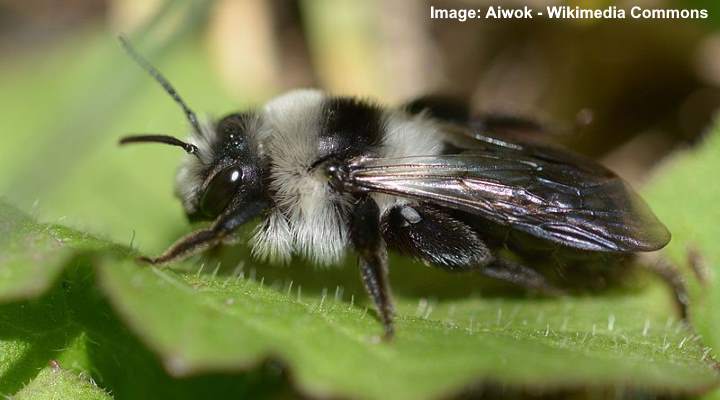
The ashy mining bee is identified by its black and white-gray furry body
The ashy mining bee is a black bee with two bands of gray-whitish hairs around its thorax. The black and white bee has an identifiable shiny black abdomen that can appear bluish in bright light. The furry bees also have two slender segmented antennae and heads covered in whitish-gray hairs. The black male ashy mining bee is entirely covered in gray hairs with a tuft of white hairs on its face.
Also called the gray mining bee, this nesting bee grows up to 0.6” (15 mm) long. The docile black and gray bee makes nests in sandy soil, river banks, and gardens. The ground nests are identifiable by the small mounds of dirt around the opening.
- Name of the Bee Family: Andrenidae
- Common nesting locations: Ashy mining bees are known to create their nests in the ground. They construct tunnels in the soil, often in areas with sandy or loamy soil and sparse vegetation, where they lay their eggs and store food for their larvae.
- Are they pollinators: Ashy mining bees are important pollinators for various wildflowers and garden plants. They are known to pollinate plants such as forget-me-nots, primroses, and other early spring-blooming flowers.
- Do they sting: Ashy mining bees are capable of stinging, but they are generally not aggressive and are not known to sting unless directly handled or threatened. Defensive behavior might be exhibited if their nest is disturbed or if they perceive a threat to their offspring.
Tawny Mining Bee (Andrenidae fulva)
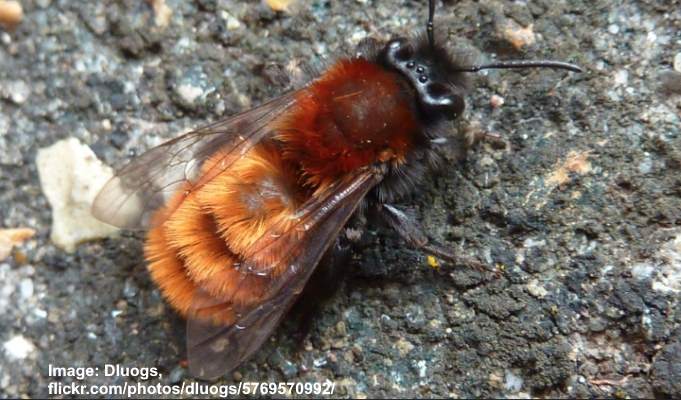
The tawny mining bee is covered with reddish-brown or orangey-brown hairs
The tawny mining bee is a furry, rusty reddish-brown or golden-brown colored species of sand bee commonly found in Europe. The nesting bee is generally non-aggressive and covered in fox-red hair on its abdomen and thorax, as well as fuzzy black hair on its head. The small reddish-orange bees measure 0.3” to 0.4” (8 – 10 mm) long.
Solitary tawny mining bees are active from March through May. You will find these reddish hairy bees feeding on pollen and nectar on daffodils, hawthorn, maple, oak, sycamore, and buttercup flowers.
The tawny mining bee is particularly prevalent in various parts of Europe, including the United Kingdom, France, Germany. As well as other European countries where suitable habitats, such as open grasslands and gardens, are available.
- Name of the Bee Family: Andrenidae
- Common nesting locations: Tawny mining bees construct their nests in the ground. They create tunnels in the soil, typically in areas with well-drained soil and sparse vegetation, where they lay their eggs and provide provisions for their larvae.
- Are they pollinators: Tawny mining bees serve as essential pollinators for various wildflowers and garden plants. They are known to pollinate plants such as fruit trees, dandelions, and other early spring-blooming flowers.
- Do they sting: Tawny mining bees are capable of stinging, but they are generally not aggressive and are not known to sting unless directly handled or threatened. Defensive behavior might be exhibited if their nest is disturbed or if they perceive a threat to their offspring.
Ivy Bee (Colletes hederae)

the striped black and pale brown ivy bee is typically solitary and nests in sandy soils
The ivy bee is a type of plasterer bee with a distinctive dark brown body and several golden-brown bands. This striped mining bee also has recognizable dense orangey-brown hairs around its thorax and a slightly fuzzy abdomen and legs. In addition, the ivy bee has large compound eyes and two segmented antennae.
Ivy bees are around 0.51” (13 mm) long and larger than other bee species in the Colletidae family. The medium-sized brown furry bee is typically solitary and doesn’t live in colonies. The bees are active from August when they feed primarily on ivy flowers. Females mine nests in the sandy soils.
Ivy bee identification
The ivy bee has an identifiable striped dark brown abdomen with bands of golden-brown hairs. In addition, a recognizable feature of the brown bee is its tuft of orange-brown hairs on its thorax and head.
Yellow-Faced Bees (Genus Hylaeus)
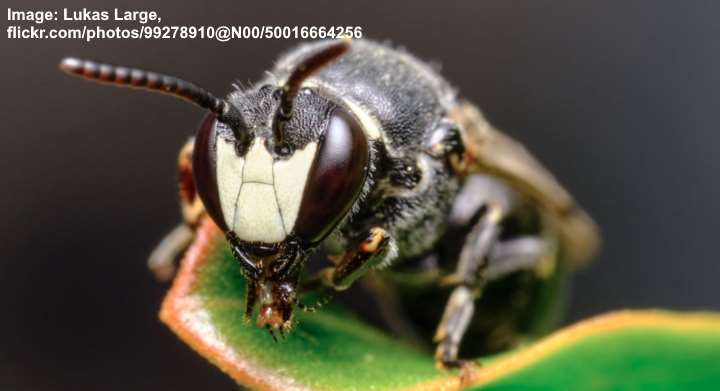
A picture of Hylaeus signatus with a pale yellow patch on its face
Also called masked bees, yellow-faced bees have a distinctive creamy-yellow patch on their face. The small black bees are easy to mistake for black wasps due to their shape. The slender bees also have characteristic yellow spots on each side of their thorax and yellow and black banded legs.
The small yellow and black bees, with their unique yellow mask-like faces, measure 0.19” to 0.27” (5 – 7 mm) long. Other identifying features of the tiny black wasp-like bees are their tubular antennae and lack of scopa—the pollen-carrying hairs on their hind legs.
Yellow-faced bees tend to nest in pre-made holes in dead wood or stems. The bees gather nectar and typically feed on ivy plants, milkweed and common boneset plants.
- Name of the Bee Family: Colletidae
- Common nesting locations: Ivy bees build their nests in the ground. They create underground burrows in sandy or well-drained soil, often in areas with abundant ivy plants, where they lay their eggs and store food for their larvae.
- Are they pollinators: Ivy bees serve as important pollinators, particularly for ivy plants. They are known to be specialized pollinators for ivy flowers, aiding in the plant’s reproduction and seed production.
- Do they sting: Ivy bees are capable of stinging, but they are generally not aggressive and are not known to sting unless directly handled or threatened. Defensive behavior might be exhibited if their nest is disturbed or if they perceive a threat to their offspring.
Furrow Bees (Genus Halictus)
Furrow bees are a large species of bees characterized by their dark brown or black appearance. In addition, some bee species have banded abdomens with yellow, brown, and black stripes. Generally, the bees live in small colonies in nests they burrow in the soil. Here are a few specific examples of common furrow bees:
Ligated Furrow Bee (Halictus ligatus)

Ligated furrow bee (Halictus ligatus)
The ligated furrow bee is identified as a dark brown bee with golden yellow bands around its abdomen. The yellow and brown bee also has tufts of yellow hairs on its head, thorax, tail, and furry yellow or orange legs. This dark black or brown-black bee lacks the metallic patterns some furrow bees have. This dark striped bee measures 0.27” to 0.43” (7 – 11 mm) long.
- Name of the Bee Family: Halictidae
- Common nesting locations: Ligated furrow bees often build their nests in the ground, particularly in areas with exposed, sandy, or loamy soil. They create small burrows in the soil where they construct cells for their eggs and store food for their young.
- Are they pollinators: Ligated furrow bees serve as important pollinators for various wildflowers and garden plants. They are known to pollinate plants such as clover, dandelions, and other flowering plants found in their habitats.
- Do they sting: Ligated furrow bees are capable of stinging, but they are generally not aggressive and are not known to sting unless directly handled or threatened. Defensive behavior might be exhibited if their nest is disturbed or if they perceive a threat to their offspring.
Confusing Furrow Bee (Halictus confusus)
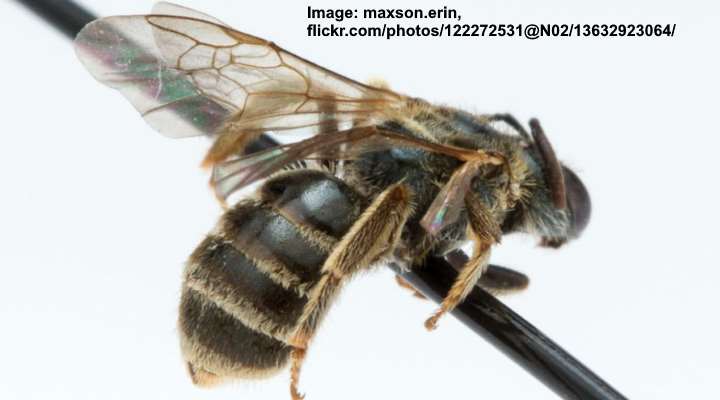
Confusing furrow bee (Halictus confusus)
The confusing furrow bee is a solitary black bee with bands of pale-yellow hairs around its abdomen. Another identifying trait of this furrow bee is fuzzy yellowish and black legs. Some confusing bees in the species are entirely black with yellow markings on their legs and face. The tiny black bee measures 0.28” (7 mm) long.
- Name of the Bee Family: Halictidae
- Common nesting locations: Confusing furrow bees typically build their nests in the ground, often in areas with well-drained soil. They create small burrows in the soil where they construct cells for their eggs and store food for their larvae.
- Are they pollinators: Confusing furrow bees are important pollinators for various wildflowers and garden plants. They are known to pollinate plants such as sunflowers, asters, and other flowering plants found in their habitats.
- Do they sting: Confusing furrow bees are capable of stinging, but they are generally not aggressive and are not known to sting unless directly handled or threatened. Defensive behavior might be exhibited if their nest is disturbed or if they perceive a threat to their offspring.
Orange-Legged Furrow Bee (Halictus rubicundus)

Orange-legged furrow bee (Halictus rubicundus)
The orange-legged furrow bee is a distinctive striped, black bee with its cylindrical body, bands of pale-yellow hairs, and black and yellow legs. The orange-legged bee also has a slender head with two large, segmented antennae. In addition, the head and thorax have short tufts of yellow-brown hairs. The small furrow bee measures less than 0.39” (10 mm) long.
- Name of the Bee Family: Halictidae
- Common nesting locations: Orange-legged furrow bees typically build their nests in the ground, particularly in areas with well-drained soil and sufficient sunlight. They create small burrows in the soil, constructing cells for their eggs and storing food for their larvae.
- Are they pollinators: Orange-legged furrow bees serve as essential pollinators for various wildflowers and garden plants. They are known to pollinate plants such as aster, goldenrod, and other flowering plants found in their habitats.
- Do they sting: Orange-legged furrow bees are capable of stinging, but they are generally not aggressive and are not known to sting unless directly handled or threatened. Defensive behavior might be exhibited if their nest is disturbed or if they perceive a threat to their offspring.
Parallel-Striped Sweat Bee (Halictus parallelus)
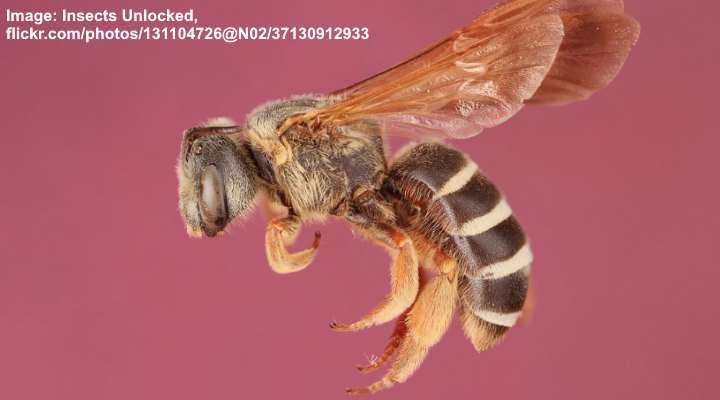
Parallel-striped sweat bee (Halictus parallelus)
The small parallel-striped sweat bee is a brown furrow bee with bands of yellow traversing its chocolatey brown abdomen. Other identifying marks of this sweat bee are its furry orange legs, golden brown head and thorax, and large, brown compound eyes. The brown and yellow bee measures 0.47” to 0.51” (12 – 13 mm).
- Name of the Bee Family: Halictidae
- Common nesting locations: Parallel-striped sweat bees typically build their nests in the ground, often in areas with well-drained soil and ample sunlight. They create small burrows in the soil, constructing cells for their eggs and storing food for their larvae.
- Are they pollinators: Parallel-striped sweat bees serve as important pollinators for various wildflowers and garden plants. They are known to pollinate plants such as sunflowers, clover, and other flowering plants found in their habitats.
- Do they sting: Parallel-striped sweat bees are capable of stinging, but they are generally not aggressive and are not known to sting unless directly handled or threatened. Defensive behavior might be exhibited if their nest is disturbed or if they perceive a threat to their offspring.
Box-Headed Blood Bee (Sphecodes monilicornis)
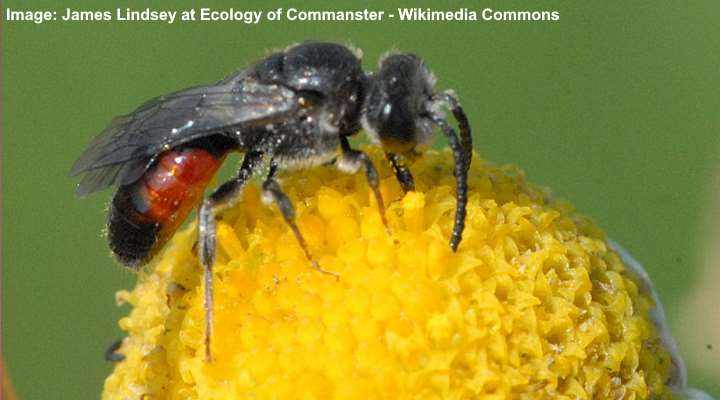
You can easily identify the box-headed blood bee with its black body and reddish abdomen
The box-headed blood bee is an unusual black bee due to its brightly colored red abdomen. The medium to large slender black and red bee has black wings, short, stumpy antennae, and fuzzy legs covered in whitish-gray hairs. Additionally, the white hairs on the black head and thorax give the bee a grayish appearance.
Blood bees are easy to recognize due to the crimson to bright red band around their bodies. This species, Sphecodes monilicornis, is easy to differentiate from other blood bees by its box-shaped head, thin body, and pale hairs.
The box-headed blood bee can be aggressive to other bees. Females usually inhabit pre-existing nests and destroy the resident grub or egg living there.
- Name of the Bee Family: Halictidae
- Common nesting locations: Box-headed blood bees do not construct their own nests. Instead, they are known as nest parasites, laying their eggs in the nests of other bees, particularly mining bees. They lay their eggs in the brood cells of other bees, where their larvae consume the provisions intended for the host bee’s offspring.
- Are they pollinators: Box-headed blood bees do not typically act as significant pollinators themselves. They primarily rely on other bees’ efforts to provide them with food and suitable nesting sites.
- Do they sting: Box-headed blood bees do possess a stinger, but they are not known to be aggressive towards humans. However, they may exhibit defensive behavior if their nesting sites are disturbed or if they perceive a threat to their larvae.
Pantaloon Bees (Dasypoda hirtipes)
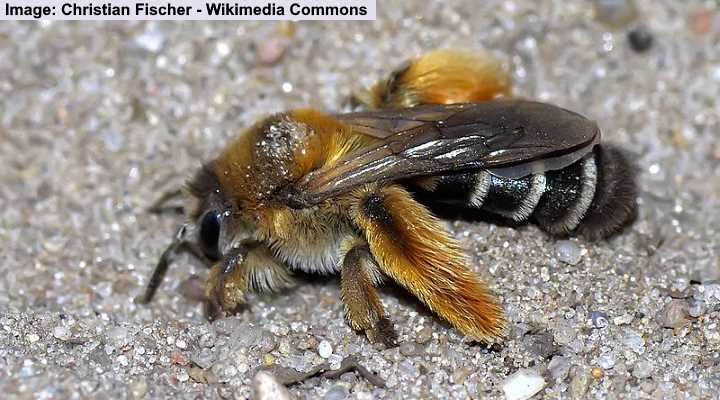
The pantaloon bees are identified by their golden hairy back legs
The pantaloon bee is a brown and golden-yellow furry mining bee with distinctive hairy hind legs. The bee’s back legs become swollen with pollen, giving them the appearance of wearing pantaloons. This medium to large bee also has a fuzzy black abdomen with grayish-white bands around it. Additionally, the bee has an easily recognizable furry golden-brown head.
Pantaloon bees measure around 0.51” (13 mm). Due to their unique appearance, these fuzzy bees also go by the name hairy-legged mining bee. Pictures of the yellowish-brown bee show its legs and head covered in dense golden-brown setae (fine hairs).
The hairy pantaloon bees are often found feeding on pollen and nectar on flowers in the Asteraceae family.
- Name of the Bee Family: Apidae
- Common nesting locations: Pantaloon bees typically build their nests in the ground, particularly in sandy or loamy soil. They create burrows in the soil, often in areas with plenty of sunlight and sparse vegetation, where they construct cells for their eggs and store food for their larvae.
- Are they pollinators: Pantaloon bees serve as effective pollinators for various wildflowers and garden plants. They are known to pollinate plants such as legumes, vetches, and other flowering plants found in their habitats.
- Do they sting: Pantaloon bees are capable of stinging, but they are not known to be aggressive. They typically only sting in response to significant threats or disturbances, especially to their nests or offspring.
Southeastern Blueberry Bee (Habropoda laboriosa)
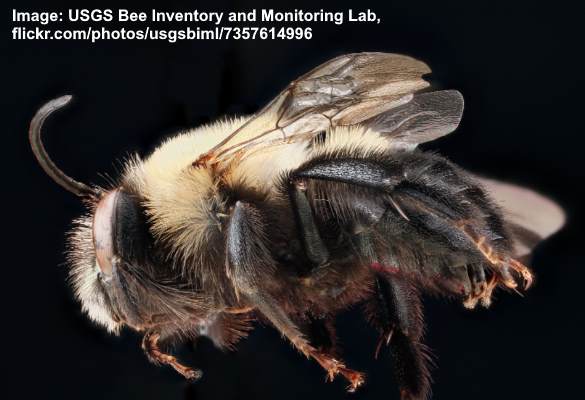
The Southeastern blueberry bee is covered in pale yellow hairs and is quite large
The southeastern blueberry bee is a solitary bee that looks like a tiny bumblebee. The black and pale-yellow nesting bee has a stout, hairy body covered in creamy-yellow hairs. In addition, there is a large tuft of yellowish hairs on its face between the two brown compound eyes.
Although smaller than a bumblebee, the blueberry bee is medium to large-sized. Females measure around 0.62” (16 mm). The difference between the male and female species is that the female’s head is entirely black, and the male has a yellowish patch on it.
This hairy black bee gets its name from its habitat—it mainly pollinates blueberry plants, hence the name blueberry bee.
- Name of the Bee Family: Apidae
- Common nesting locations: Southeastern blueberry bees build their nests in the ground, typically in areas with loose, sandy soil. They create small burrows in the soil, where they construct cells for their eggs and store food provisions for their larvae.
- Are they pollinators: Southeastern blueberry bees are essential pollinators, particularly for blueberry plants and other flowering plants native to southeastern regions. They are known to be efficient and effective pollinators for various wildflowers and blueberry crops.
- Do they sting: Southeastern blueberry bees are capable of stinging, but they are not known to be aggressive. They typically only sting in response to significant threats or disturbances, especially to their nests or offspring.
Africanized Honey Bee

Africanized honey bee (Apis mellifera scutellata)
The Africanized honey bee is a non-native aggressive bee and is sometimes called the killer bee. This honey bee species is typically orange-yellow with dark brown or black bands traversing its abdomen. The large African “killer bee” measures 0.74” (19 mm) and is smaller than the European honey bee.
The Africanized honey bee is a hybrid of various honey bee species—Apis mellifera (western honey bee), Apis mellifera scutellata (East African lowland honey bee), Apis mellifera ligustica (Italian honey bee), and Apis mellifera iberiensis (Iberian honey bee).
Although classified as an aggressive bee, the Africanized honey bee’s behavior results from defending its territory. Also, its sting isn’t any more potent than the sting of a European honey bee.
- Name of the Bee Family: Apidae
- Common nesting locations: Africanized honey bees build nests in enclosed spaces, such as tree cavities, crevices, or man-made structures. They create intricate, organized honeycombs within their nests to store honey and raise their brood.
- Are they pollinators: Africanized honey bees serve as crucial pollinators for various crops and wildflowers. They contribute to the pollination of numerous plants, including but not limited to citrus trees, sunflowers, and various other agricultural crops.
- Do they sting: Africanized honey bees are known for being more defensive than other honey bee species. They are capable of stinging and often exhibit aggressive behavior when their hive is disturbed or when they perceive a threat to their colony. It is important to exercise caution and respect when near their nests to avoid provoking defensive responses.
Nomad Bees (Genus Nomada)
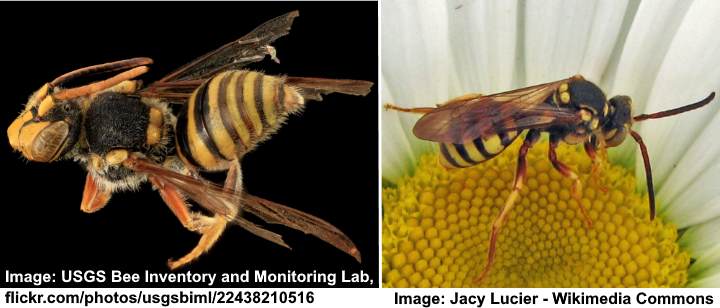
Nomada bees: Nomada affabilis (left) and Nomada luteoloides (right)
Nomad bees look more like black and yellow wasps than a typical bee. The small striped bee measures 0.31” to 0.39” (8 – 10 mm) and has a distinctive yellow and black abdomen, orange antennae, and yellowish legs. An easy way to tell the nomad bees apart from other bees is their hairless bodies.
Here are two examples of nomad bees:
Nomada affabilis: The yellow bee has a tear-shaped abdomen with traversing brown and yellow bands. It has a black fuzzy thorax and a striking deep yellow face with curled, orange-colored segmented antennae.
Nomada luteoloides: This nomad bee has a flattened yellow oval abdomen with brown-black stripes. The rest of the bee’s body is primarily black, apart from yellow dots surrounding its thorax. The bee also has rusty brown and yellow legs and dark brownish-red antennae.
- Name of the Bee Family: Apidae
- Common nesting locations: Nomad bees do not build their own nests. Instead, they are known as nest parasites, laying their eggs in the nests of other bees, particularly mining bees. They lay their eggs in the brood cells of other bees, where their larvae consume the provisions intended for the host bee’s offspring.
- Are they pollinators: Nomad bees, while not primary pollinators themselves, indirectly contribute to pollination by aiding in the control of populations of other bee species. By parasitizing the nests of other bees, they help maintain a balance in the bee population, which can ultimately benefit overall pollination in various ecosystems.
- Do they sting: Nomad bees do not possess stingers. They do not exhibit stinging behavior as they do not have the physical attributes necessary for stinging.
Long-Horned Bees (Genus Eucera)
Long-horned bees are native bees in North America characterized by their thick layer of fur and extra long curved antennae. The furry bee species is generally black with whitish setae covering the body, giving the bee a grayish appearance. The medium-sized hairy bee typically measures 0.43” to 0.80” (11 – 18 mm) long.
Here are a few examples of dark-colored bees in the Eucera genus:
Eucera actuosa: A blackish-gray bee with a stout oval body, furry thorax, two protruding compound eyes, and long smooth antennae.
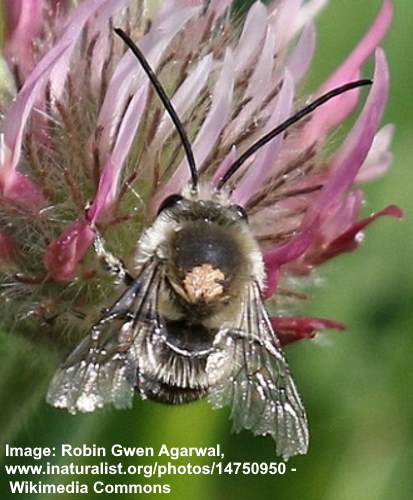
Eucera actuosa
Eucera fulvitarsis: A black bee with a gray covering of fine setae on its head and thorax and golden hairy legs. In flight, the bee’s orangey legs dangle down.
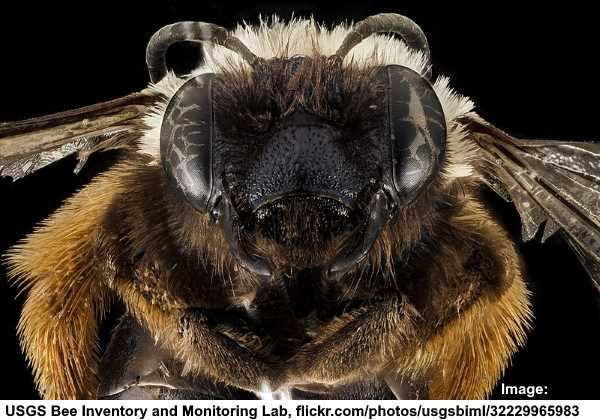
Eucera fulvitarsis
Eucera frater: A brown and black bee with a stumpy oval body, black abdomen, brown hairy thorax, and fuzzy gray legs. Unusual features of this fuzzy bee are its large eyes on the side of its head and long, curved, insect-like antennae.
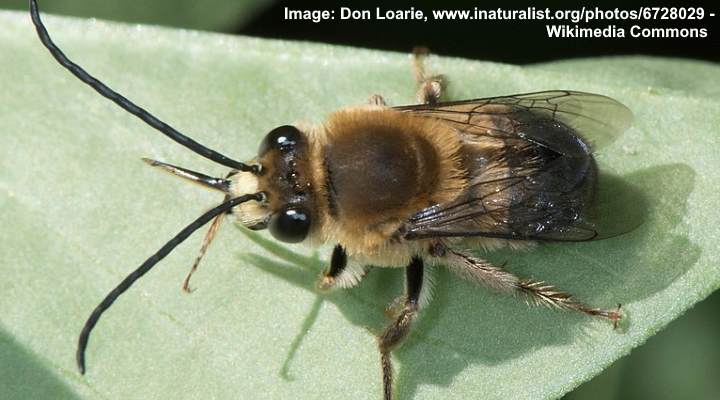
Eucera frater
- Name of the Bee Family: Apidae
- Common nesting locations: Long-horned bees typically build their nests in the ground, often in areas with sandy or loamy soil. They create burrows in the soil, constructing cells for their eggs and storing food provisions for their larvae. Some species may also nest in preexisting cavities or hollow stems.
- Are they pollinators: Long-horned bees serve as essential pollinators for various wildflowers and flowering plants. They are known to be efficient pollinators for plants such as sunflowers, legumes, and other flowering plants found in their habitats.
- Do they sting: Long-horned bees are capable of stinging, but they are not known to be aggressive. They typically only sting in response to significant threats or disturbances, especially to their nests or offspring.
Stingless Honey Bees (Meliponines)
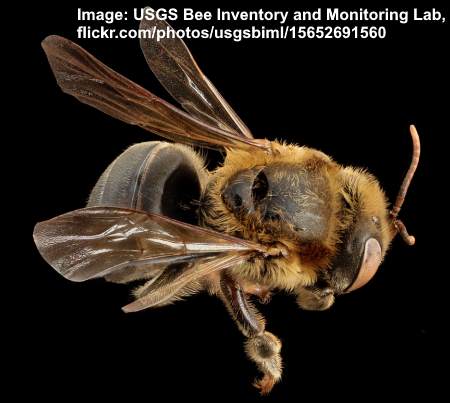
Stingless honey bee (Meliponines)
There are many species of stingless bees, each with its own characteristics. While they possess a stinger, it is much less developed than that of other bee species. The stinger of the meliponines is often too small and ineffective to penetrate human skin, making them relatively harmless to humans in terms of stinging. As a result, they are often referred to as “stingless” bees.
However, they can still exhibit defensive behavior when their hives are threatened. They may bite or release defensive chemicals, which can cause minor irritation but are not typically harmful.
The stingless bee Meliponula ferruginea is an orange bee with a shiny black head, a black thorax with sparse hairs, and an orange abdomen with black stripes. However, other stingless bees look entirely different. For example, one species is black with a short body covered in golden-brown hairs and a rounded rather than flattened head.
Stingless bees can be found in various tropical and subtropical regions around the world. They are particularly prevalent in Central and South America, including countries such as Brazil, Mexico, and Colombia. Additionally, they are also found in parts of Southeast Asia, Africa, and Australia.
- Name of the Bee Family: Apidae
- Common nesting locations: Stingless honey bees build their nests in various locations, including tree cavities, hollow logs, and other enclosed spaces. They construct intricate, organized honeycombs within their nests to store honey and raise their brood. These bees can also be found in man-made hives designed specifically for them.
- Are they pollinators: Stingless honey bees are efficient pollinators for a variety of flowering plants and crops. They contribute to the pollination of numerous plants, including but not limited to tropical fruits, herbs, and wildflowers, playing a crucial role in maintaining biodiversity and supporting ecosystem health.
- Do they sting: Stingless honey bees do not possess a traditional stinger like other bee species. While they can bite to defend themselves, they are not known for aggressive behavior and are considered less likely to sting compared to other bee species. However, they may exhibit defensive behavior if their nests are threatened or disturbed.
Cuckoo Bees (Nomadinae)

An close up image of cuckoo bee Nomada fulvicornis
Cuckoo bees are a family of wasp-like bees with slender bodies, stumpy segmented antennae, and orange colors. Some cuckoo bees have orangey-red legs and antennae. In contrast, others have black fuzzy legs, a black thorax, and a bulbous orange abdomen. However, some cuckoo bees resemble bumblebees and have similar behavior.
Cuckoo bees get their name from the way the females lay their eggs in the nests of other bees. This habit called kleptoparasitism means that different species of bees will raise and feed the young.
- Name of the Bee Family: Apidae
- Common nesting locations: Cuckoo bees do not build their own nests. Instead, they are known as nest parasites, laying their eggs in the nests of other bees, particularly mining bees. They lay their eggs in the brood cells of other bees, where their larvae consume the provisions intended for the host bee’s offspring.
- Are they pollinators: Cuckoo bees, while not primary pollinators themselves, indirectly contribute to pollination by aiding in the control of populations of other bee species. By parasitizing the nests of other bees, they help maintain a balance in the bee population, which can ultimately benefit overall pollination in various ecosystems.
- Do they sting: Cuckoo bees do not possess stingers. They do not exhibit stinging behavior as they do not have the physical attributes necessary for stinging. They rely on their parasitic behavior for survival rather than defensive mechanisms.
Orchid Bees (Euglossini)
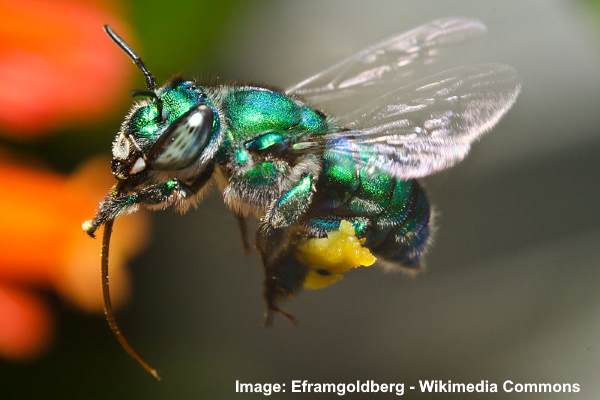
A picture of the orchid bee euglossa viridissima which is identified by its metallic green body
Orchid bees are a fascinating tribe of bees with metallic green bodies that look like armored vehicles. There are about 200 species of these large, solitary bees. It’s easy to distinguish orchid bees from other bee species. They are generally hairless and have shiny metallic coloration.
Although shiny green is the predominant color, other orchid bees can be shiny blue, red, gold, or purple. Some of the most spectacular orchid bees are a combination of colors, and some have orange or yellow stripes.
Orchid bees get their name because they mainly pollinate orchid flowers.
- Name of the Bee Family: Apidae
- Common nesting locations: Orchid bees typically build their nests in preexisting cavities such as tree hollows or crevices. They might also construct their nests in abandoned insect burrows or in artificial bee houses specifically designed for them. Their nests often contain a series of brood cells where the female bee lays her eggs and stores food for the developing larvae.
- Are they pollinators: Orchid bees are important pollinators, especially for various orchid species. They also contribute to the pollination of other flowering plants in tropical and subtropical regions.
- Do they sting: Orchid bees are generally not aggressive and are not known to sting unless directly provoked or threatened. They primarily focus on their foraging and pollination activities rather than defensive behavior, making them relatively docile in their interactions with other organisms.
Digger Bees (Anthophorini)
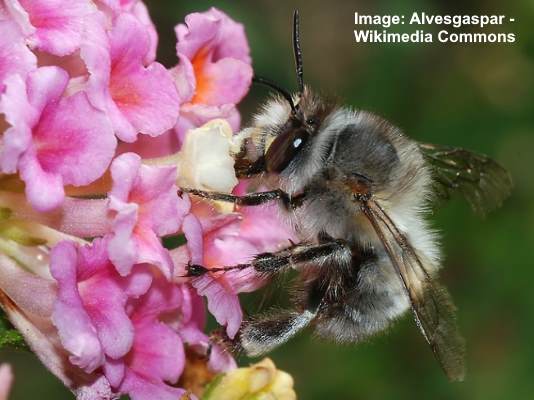
The large digger bees have black body covered in white hairs
Digger bees are large solitary insects with a grayish appearance due to their black bodies being covered in white hairs. These robust, hairy bees can measure up to 1.18” (30 mm) long. They get their name from their nesting habit of digging tunnels into the soil to raise young.
There are some common characteristics of the 750 species of digger bees. For example, their wings typically appear shorter than typical bees. Because of this, the buzz they make is more like a high-pitched whine. Many species also have metallic bands traversing their abdomens.
- Name of the Bee Family: Apidae
- Common nesting locations: Digger bees construct their nests in the ground. They dig burrows in the soil, often in sandy or loamy areas, creating tunnels where they lay their eggs and store pollen for their offspring. These bees are known for their efficient excavation abilities, and their nesting sites can be found in various terrestrial habitats.
- Are they pollinators: Digger bees play a vital role as pollinators for a wide range of flowering plants, including wildflowers, crops, and garden plants. They collect pollen to provision their nests and inadvertently transfer pollen grains from one flower to another during their foraging activities, contributing significantly to the process of plant reproduction.
- Do they sting: Digger bees are generally not aggressive and are not prone to stinging unless they feel directly threatened or provoked. They are more focused on their nesting and foraging activities and are less likely to exhibit defensive behavior unless their nests are disturbed or tampered with.
Square-Spotted Mourning Bee (Melecta luctuosa)

Square-Spotted Mourning Bee (Melecta luctuosa)
The square-spotted mourning bee is a fuzzy black bee that has patches of white hairs along its abdomen, thorax, and head. From a distance, the small bee looks like a furry black insect with white spots. The white-spotted black bees measure 0.47” to 0.55” (12 – 14 mm) long.
Other identifying features of the black and white square-spotted mourning bee are its translucent dark brown pair of wings, thick, black antennae, and kidney-shaped black compound eyes.
- Name of the Bee Family: Apidae
- Common nesting locations: Square-spotted mourning bees typically build their nests in the burrows of other bees, particularly those belonging to the mining bee genus Andrena. They are known as cleptoparasites, laying their eggs in the host bee’s nest, and their larvae consume the provisions meant for the host’s offspring. Therefore, their nesting locations are closely associated with the nesting sites of their host bees.
- Are they pollinators: Square-spotted mourning bees, while not significant pollinators themselves, indirectly impact pollination through their parasitic interactions with other bee species, particularly the Andrena mining bees. By controlling the population of their host bees, they may indirectly affect the pollination dynamics of the plants that the host bees typically visit for foraging and nesting purposes.
- Do they sting: Square-spotted mourning bees, similar to other parasitic bees, are not typically known for aggressive behavior or stinging. They primarily focus on their parasitic activities and do not exhibit defensive behavior unless directly threatened or interfered with during their interactions with their host bees.
Bellflower Resin Bee (Megachile campanulae)
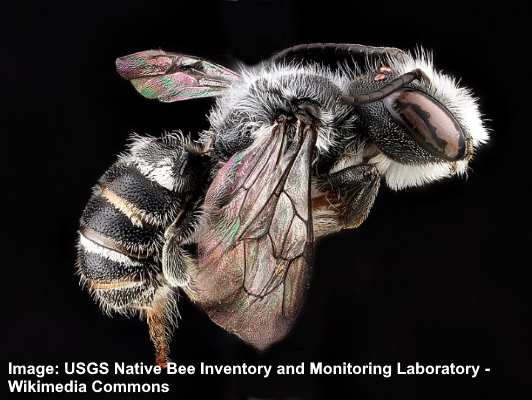
Bellflower Resin Bee (Megachile campanulae)
The bellflower resin bee is a hairy black bee with white stripes around its abdomen. The bee has an overall grayish appearance because of the whitish-gray hairs covering its black body. The bellflower resin bee has oval compound eyes on the side of its head and two curved antennae.
The black and white bellflower resin bee is a medium-sized bee that measures 0.4” to 0.47” (10 – 12 mm) long. Resin bees are found throughout the eastern part of North America. In addition, the furry bees are found from Ontario to Florida and as far west as Texas and Minnesota.
- Name of the Bee Family: Megachilidae
- Common nesting locations: Bellflower resin bees are known to build their nests in pre-existing cavities, such as hollow plant stems or holes in wood. They use plant resins to construct partitions within these nesting sites, creating individual cells for their larvae. These bees are often found in areas where bellflowers, their preferred foraging plants, are abundant.
- Are they pollinators: Bellflower resin bees are effective pollinators, especially for bellflowers and related plant species. They actively collect pollen and nectar from bellflower flowers, inadvertently facilitating cross-pollination as they move between flowers to gather resources for their nests.
- Do they sting: Bellflower resin bees are not known to be aggressive and rarely sting unless provoked or handled. They are generally docile and prefer to focus on foraging and nest-building activities rather than exhibiting defensive behavior.
Wool Carder Bee (Anthidium maculosum)
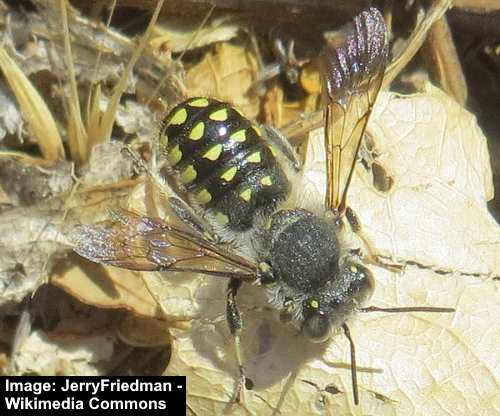
Wool Carder Bee (Anthidium maculosum)
The wool carder bee belongs to the family Megachilidae. These medium-sized bees are recognizable by their robust, black bodies with distinct white or yellow markings. Their characteristic appearance includes a dense coat of hairs on their thorax and abdomen, aiding in the collection and transport of pollen.
The name “wool carder bee” is derived from the bee’s behavior of collecting plant hairs, or trichomes, to construct its nest, similar to how a wool carder collects and arranges wool fibers for carding and spinning. The female wool carder bee scrapes hairs from the leaves of specific plants, such as lamb’s ear (Stachys byzantina), to line its nest and create partitions between egg chambers.
They are solitary bees, meaning they do not form complex colonies or hives like some other bee species. Instead, each female constructs and provisions her own nest, laying eggs and providing a supply of pollen and nectar for the developing larvae.
Male wool carder bees are slightly smaller than the female wool carder bees. They have slender bodies and vibrant yellow markings on their faces and along the sides of their abdomens. They are often territorial, fiercely defending patches of flowers against other insects and male bees.
In contrast, female wool carder bees have robust, black bodies with conspicuous white or pale yellow markings on their abdomens. They have dense, hair-like structures on their legs, aiding in the collection and transportation of pollen.
- Name of the Bee Family: Megachilidae.
- Common nesting locations: They are known to construct nests in various pre-existing cavities, such as hollow plant stems, beetle burrows, or other similar structures, using plant hairs or trichomes for lining.
- Are they pollinators: Yes, wool carder bees are important pollinators, visiting a variety of flowering plants during their foraging activities.
- Do they sting: Wool carder bees are capable of stinging, although they are not typically aggressive and tend to sting only in response to direct threats or disturbances to their nests or territories.
How to Attract Different Types of Bees
To attract different types of bees to your garden, focus on planting a diverse range of flowers that offer various shapes, colors, and scents. Include a mix of native wildflowers and garden plants to provide a variety of food sources for different bee species. Make sure to create a continuous bloom from early spring to late fall to offer a consistent food source throughout the growing season.
Bees also need a water source, so consider setting up a shallow water container with some pebbles to help them access water easily without the risk of drowning. Additionally, avoid using pesticides as they can be harmful to bees and other beneficial insects. Instead, opt for natural pest control methods or plant bee-friendly species that naturally repel pests.
To further encourage bees to your garden, create a bee-friendly habitat by installing bee hotels or nesting blocks to attract solitary bees that nest in preexisting holes. Opt for native plants as they are more likely to attract local bee species that have evolved alongside these plants.
Aim to create a sunny, sheltered location for your garden, as bees prefer sunny spots with some protection from strong winds.
Plant flowers in groups to create patches of color that are more easily visible to bees, and offer a variety of flower shapes and sizes to accommodate bees with different tongue lengths.
How to Support the Health of All Types of Bees
Supporting the health of all types of bees requires creating a diverse and pesticide-free environment rich in native flowers, trees, and shrubs to offer a variety of pollen and nectar sources.
Use organic or natural pest control methods to protect bees from harmful chemicals. Establish bee-friendly habitats such as bee hotels, nesting blocks, and undisturbed areas with bare, unmulched soil to accommodate different nesting preferences.
Additionally, ensure the availability of a shallow water source with floating cork pieces or pebbles to provide bees with a safe drinking spot.
What’s the Difference Between Social Bees and Solitary Bees?
Social bees, such as honey bees and bumblebees, live in highly organized colonies where they exhibit complex social behaviors. These colonies consist of a queen responsible for reproduction, drones that mate with the queen, and worker bees that perform various tasks like foraging, nursing the young, and building and maintaining the nest.
Communication within social bee colonies is sophisticated, involving intricate dances and chemical signals to coordinate activities and convey vital information.
Social bees produce and store significant amounts of honey and beeswax, crucial for sustaining the colony, especially during periods of scarcity. Their cooperative behaviors and efficient foraging contribute to the successful survival and propagation of the entire colony.
On the other hand, solitary bees, encompassing various species like mason bees, leafcutter bees, and mining bees, operate independently. Each female constructing and provisioning her own nest without the assistance of a colony.
Unlike social bees, solitary bees do not produce honey or beeswax, and they exhibit no complex social hierarchy or cooperative activities. These bees often nest in preexisting holes, plant stems, or underground tunnels, with each female responsible for laying eggs and providing provisions for her offspring.
While solitary bees do not have the same degree of social organization as their counterparts, their contribution to pollination remains significant, as they play a crucial role in the reproductive cycle of various plant species, making them essential parts of diverse ecosystems.
Related articles:
